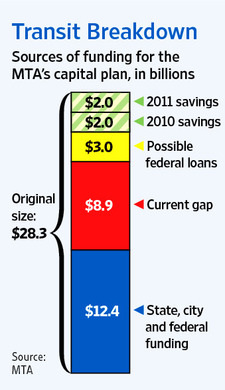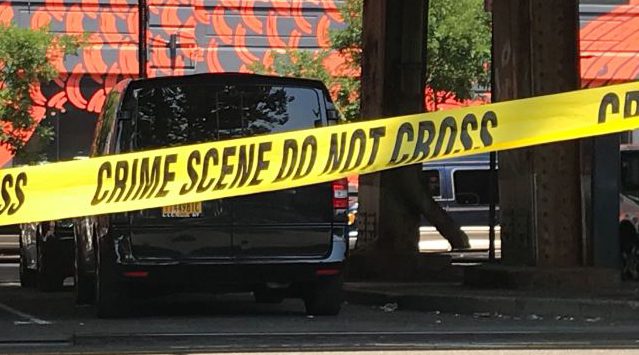
Jay Walder's surprise resignation announcement last week overshadowed some important news about the MTA's finances: The agency has identified $2 billion in savings in its capital program [PDF], which maintains and expands the transit system, but expects $1 billion less in federal assistance. That brings the total gap in the five-year, $26 billion capital plan to $9 billion that must be accounted for by the end of the year. This enormous deficit will define the political context in which Governor Andrew Cuomo chooses Walder's replacement.
First the good news: The cuts do seem to trim fat, not muscle. The $2 billion in savings come largely from reduced construction costs due to the weak economy and more efficient operations. Though the cutbacks will include changes to how tracks and train cars are maintained, the transit agency says that riders should not be negatively affected.
The efficiency-finding is encouraging, but the bad news is that unless Albany fulfills its responsibility to fund transit, enormous fare hikes or spending cuts that will hurt riders are still looming.
The biggest savings, worth $800 million, come from reduced construction costs due to the weak economy. Another $150 million will come from reductions in administrative costs and payroll.
The savings also include 10 percent spending cuts on both transit vehicles and tracks. In the past, the MTA would use broken tracks as an opportunity to work on entire sections of the system; now, the agency will instead fix only the broken piece. That means more frequent but smaller repair jobs. The MTA will also eliminate replacement bus service during track outages where an alternate subway route is available (this change, at least, will affect riders).
The MTA intends to save another chunk by overhauling the way it buys trains and buses. By changing the design standards it puts out to vendors to better match how the MTA actually uses its vehicles, the theory goes, the MTA will be able to reduce maintenance costs.
"Our rolling stock initiative is less about extending the useful life of trains and buses," explained an MTA spokesperson, "and more about being smarter about how we partner with suppliers and being smarter about how we review design specifications to ensure we’re not making cars too heavy or doing other things that cause other expenses down the road.”
"This $2 billion seems to be all about good management," said Hope Cohen, the associate director of the Regional Plan Association's Center for Urban Innovation, who said that these cuts likely won't hurt riders. "Anything more significant or controversial will be coming later."
The $2 billion in savings come on top of a previous $2 billion in cuts to the MTA's current five-year capital program, proof that under Walder, the efficiencies to be found in the transit agency's spending were being found.
Even assuming these savings materialize as promised, however, an enormous hole remains in the capital program. Albany funded only the first two years of the program after refusing to include bridge tolls in the 2009 MTA funding package.
As things stand today, Governor Cuomo and the state legislature have five months until the essential work of maintaining and expanding the transit system can no longer be paid for. Where the revenue will come from to cover $9 billion in unfunded construction and repairs remains to be seen.
"We recognize that there's no appetite for new taxes in New York today," Walder said in a statement last week. But restructuring those taxes in the form of a 32 percent fare hike would prove just as politically toxic, though the howls would come from a different set of New Yorkers. None of the other options -- enormous service cuts, a halt to basic repairs and construction projects like the Second Avenue Subway, or road pricing -- could be enacted without stirring up significant opposition. There's a big fight coming no matter what.
The need to replace Walder complicates the politics of the capital plan. In choosing who will run the MTA, Governor Andrew Cuomo will also choose, to an extent, how the agency responds to its enormous deficit. If Cuomo wants to fight for transit riders and secure the needed funding for the MTA, he can entrust a competent leader with the task of making that case to the legislature and the voters. If Cuomo wants the entire capital deficit to fall on relatively low-income transit riders, he can choose someone who will go along with massive fare hikes and absorb the public's outrage.
Advocates and elected officials alike have called on Cuomo to appoint another experienced transit professional to replace Walder. Cuomo also needs to give the next MTA chief a job description that includes strengthening the region's transit system, not managing its decline.





